Submitted:
18 April 2023
Posted:
19 April 2023
You are already at the latest version
Abstract

Keywords:
1. Introduction
2. Experimental Setup
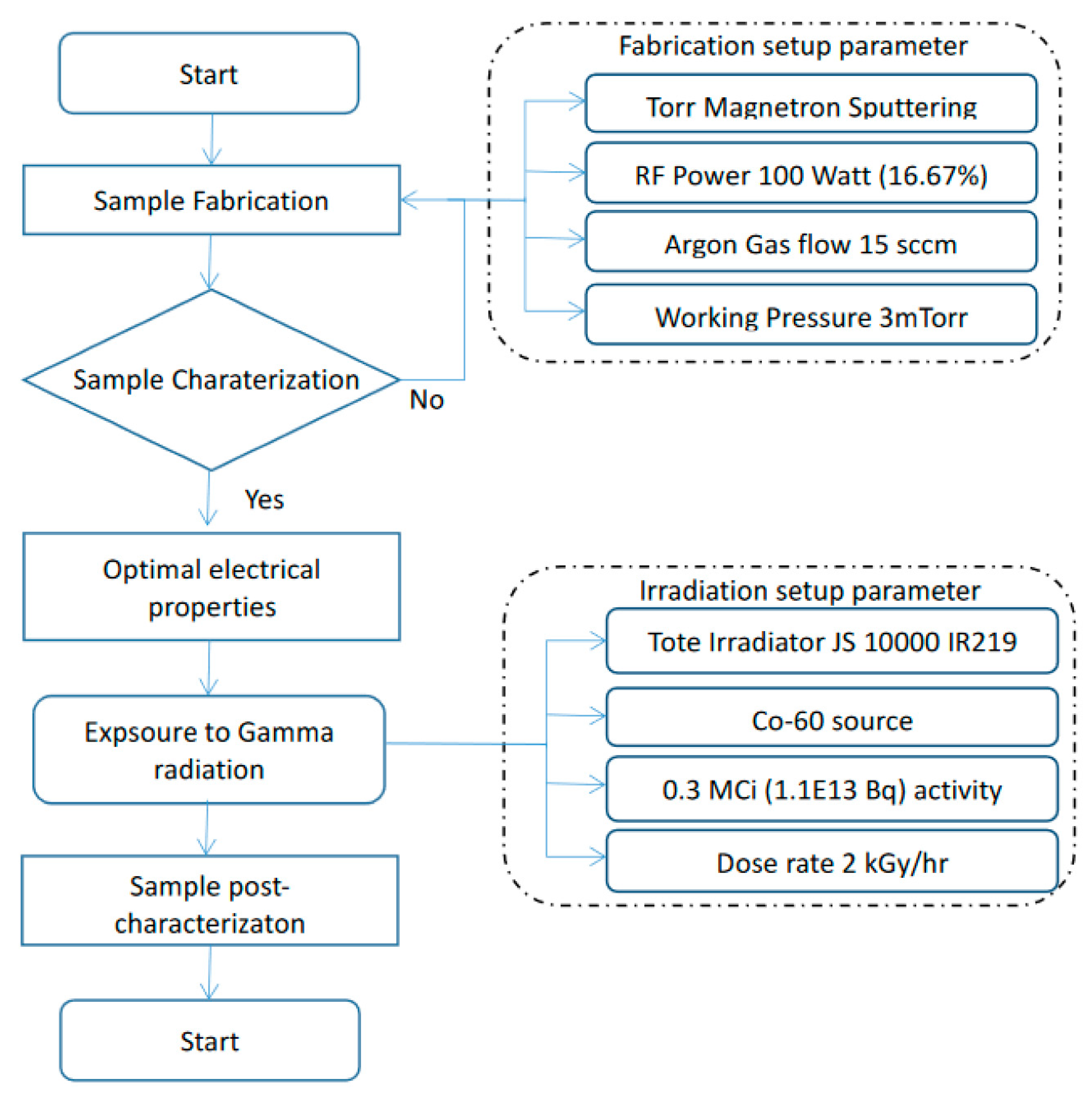
2.1. Mathematical approach on the extraction of Schottky diode parameters.
2.2. Finite element analysis Governing equation
2.2.1. Carrier Transport Mathematical Equation
2.2.2. Carrier Generation-Recombination Mathematical Equation
2.2.3. Mobility Expressions
3. I–V characteristics curve of ZnO irradiated with gamma
3.1. Simulation Findings
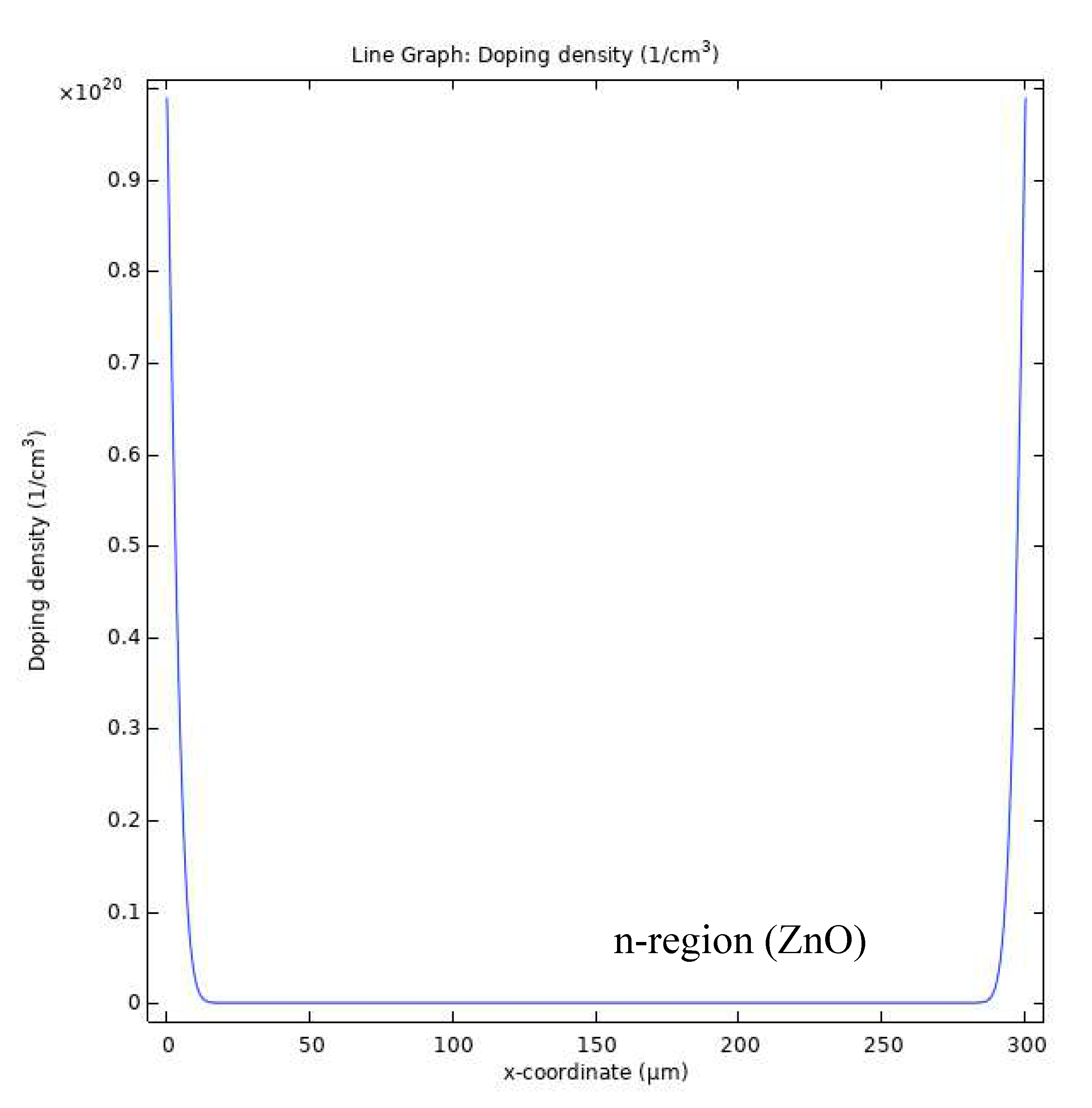
3.1.1. Steady state analysis
Conclusion
Acknowledgments
References
- Duinong, M., Rasmidi, R., Chee, F. P., Moh, P. Y., Salleh, S., Mohd Salleh, K. A., & Ibrahim, S. (2022). Effect of Gamma Radiation on Structural and Optical Properties of ZnO and Mg-Doped ZnO Films Paired with Monte Carlo Simulation. Coatings, 12(10), 1590. [CrossRef]
- Mivolil, D. S., Chee, F. P., Rasmidi, R., Alias, A., Salleh, S., & Salleh, K. A. M. (2020). Gamma ray and neutron radiation effects on the electrical and structural properties of n-ZnO/p-CuGaO2 Schottky diode. ECS Journal of Solid State Science and Technology, 9(4), 045019. [CrossRef]
- Chee, F. P., Duinong, M. I. V. O. L. I. L., Rani, A. I. A., Chang, J. H. W., Alias, A. F. I. S. H. A. H., & Salleh, S. A. A. F. I. E. (2019). Simulation of displacement damage cross section of cuprous oxide/zinc oxide (Cu2O/ZnO) based heterojunction device. J. Eng. Sci. Technol, 14(4), 1820-1834.
- Liu, Y.; Wu, W.-J.; En, Y.-F.; Wang, L.; Lei, Z.-F.; and Wang, X.-H. (2014). Total dose ionizing radiation effects in the indium-zinc oxide thin-film transistors. IEEE Electron Device Letters, 35(3), 369-371. [CrossRef]
- Indluru, A.; Holbert, K.E.; and Alford, T.L. (2013). Gamma radiation effects on indium-zinc oxide thin-film transistors. Thin Solid Films, 539, 342-344. [CrossRef]
- Lee, E. H., Indluru, A., Allee, D. R., Clark, L. T., Holbert, K. E., & Alford, T. L. (2011). Effects of gamma irradiation and electrical stress on a-Si: H thin-film transistors for flexible electronics and displays. Journal of Display Technology, 7(6), 325-329. [CrossRef]
- Nastasi, M.; Mayer, J.W.; and Hirvonen, J.K. (1996). Ion-solid interactions: fundamentals and applications. Cambridge, United Kingdom: Cambridge University Press.
- Chee, F.P.; Amir, H.F.A.; and Salleh, S. (2011). Range distribution and electronic stopping power for Cobalt (Co) ions in Gallium Arsenide (GaAs) optoelectronic devices. Proceedings of the 4 th International Conference on Modeling, Simulation and Applied Optimization (ICMSAO). Kuala Lumpur, Malaysia, 1-5. [CrossRef]
- Wendler, E. (2009). Mechanisms of damage formation in semiconductors. Nuclear Instruments and Methods in Physics Research Section B: Beam Interactions with Materials and Atoms, 267(16), 2680-2689. [CrossRef]
- Movla, H.; Babazadeh, M.; and Sadreddini, S.V. (2016). Influence of α particle radiation on the structural and electronic properties of thin film GaAs solar cells: A simulation study. Optik, 127(8), 3844-3847. [CrossRef]
- Jalili, M., Jinap, S., & Noranizan, M. A. (2012). Aflatoxins and ochratoxin a reduction in black and white pepper by gamma radiation. Radiation Physics and Chemistry, 81(11), 1786-1788. [CrossRef]
- Mohiju, Z. A., Adnan, N. A., Hamid, N. A., & Abdullah, Y. (2018). Phase formation and microstructure of gamma irradiated Bi-2223 Superconductor. In IOP Conference Series: Materials Science and Engineering (Vol. 298, No. 1, p. 012021). IOP Publishing. [CrossRef]
- Hamid, N. A., Mohiju, Z. A., Jamal, N. F., & Abdullah, Y. (2017). Effect of low doses gamma and electron irradiation on mechanical strength of Bi2Sr2CaCu2O8 (Bi-2212) superconductor ceramics. In Materials Science Forum (Vol. 880, pp. 45-49). Trans Tech Publications Ltd. [CrossRef]
- Hamid, N. A., & Abdullah, Y. (2019, June). Impact of gamma and electron irradiations on superconducting properties of Bi1. 6Pb0. 4Sr2Ca2Cu3O10 (Bi-2223) superconductor. In IOP Conference Series: Materials Science and Engineering (Vol. 555, No. 1, p. 012025). IOP Publishing. [CrossRef]
- Baharin, R., Ramli, S., Hairaldin, S. Z., & Ahmad, R. (2020, April). Risk analysis and hazard identification at ALURTRON and MINTec-Sinagama. In IOP Conference Series: Materials Science and Engineering (Vol. 785, No. 1, p. 012050). IOP Publishing. [CrossRef]
- Cheung, S. K., & Cheung, N. W. (1986). Extraction of Schottky diode parameters from forward current-voltage characteristics. Applied physics letters, 49(2), 85-87. [CrossRef]
- Rhoderick, E. H., & Williams, R. H. (1988). Metal-semiconductor contacts (Vol. 252). Oxford: Clarendon press.
- Gwyn, C. W., Scharfetter, D. L., & Wirth, J. L. (1967). The analysis of radiation effects in semiconductor junction devices. IEEE Transactions on nuclear science, 14(6), 153-169. [CrossRef]
- Coehoorn, R., Van Eersel, H., Bobbert, P., & Janssen, R. (2015). Kinetic Monte Carlo study of the sensitivity of OLED efficiency and lifetime to materials parameters. Advanced Functional Materials, 25(13), 2024-2037. [CrossRef]
- Elgazzar, A. H., & Kazem, N. (2014). Biological effects of ionizing radiation. In The pathophysiologic basis of nuclear medicine (pp. 715-726). Cham: Springer International Publishing. [CrossRef]
- Korchuganov, A. V., Zolnikov, K. P., Kryzhevich, D. S., Chernov, V. M., & Psakhie, S. G. (2015). Generation of shock waves in iron under irradiation. Nuclear Instruments and Methods in Physics Research Section B: Beam Interactions with Materials and Atoms, 352, 39-42. [CrossRef]
- Gilbert, M. R., Marian, J., & Sublet, J. C. (2015). Energy spectra of primary knock-on atoms under neutron irradiation. Journal of nuclear materials, 467, 121-134. [CrossRef]
- Gilbert, M. R., & Sublet, J. C. (2016). PKA distributions: Contributions from transmutation products and from radioactive decay. Nuclear Materials and Energy, 9, 576-580. [CrossRef]
- Salari, M. A., Güzeldir, B., & Sağlam, M. (2018, February). The effects of gamma irradiation on electrical characteristics of Zn/ZnO/n-Si/Au-Sb structure. In AIP Conference Proceedings (Vol. 1935, No. 1, p. 050002). AIP Publishing LLC. [CrossRef]
- Salari, M. A., Sağlam, M., & Güzeldir, B. (2019). The protection from the effects of gamma rays of metal-semiconductor diodes by means of ZnO thin interface layer. Radiation Physics and Chemistry, 165, 108416. [CrossRef]
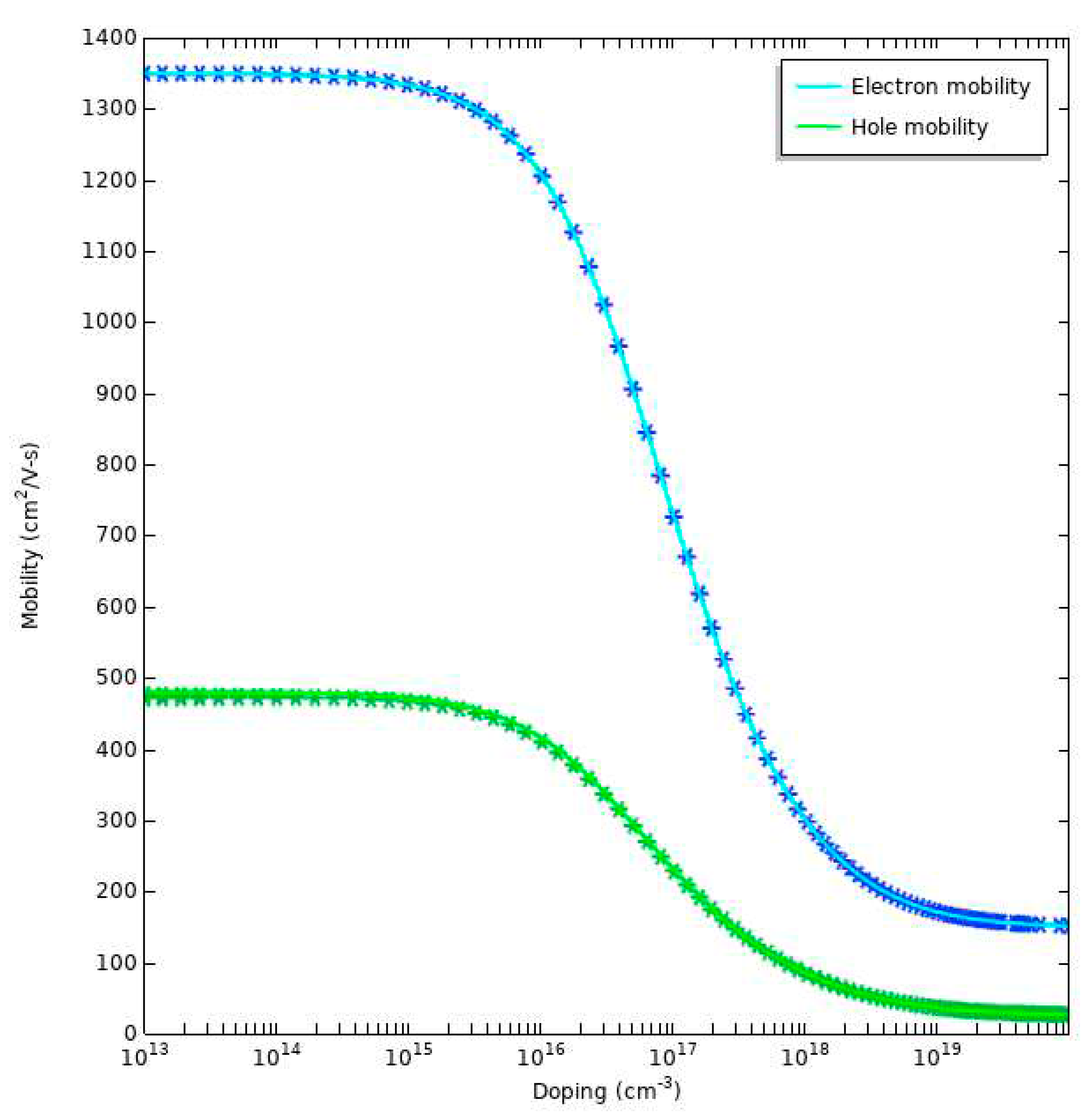

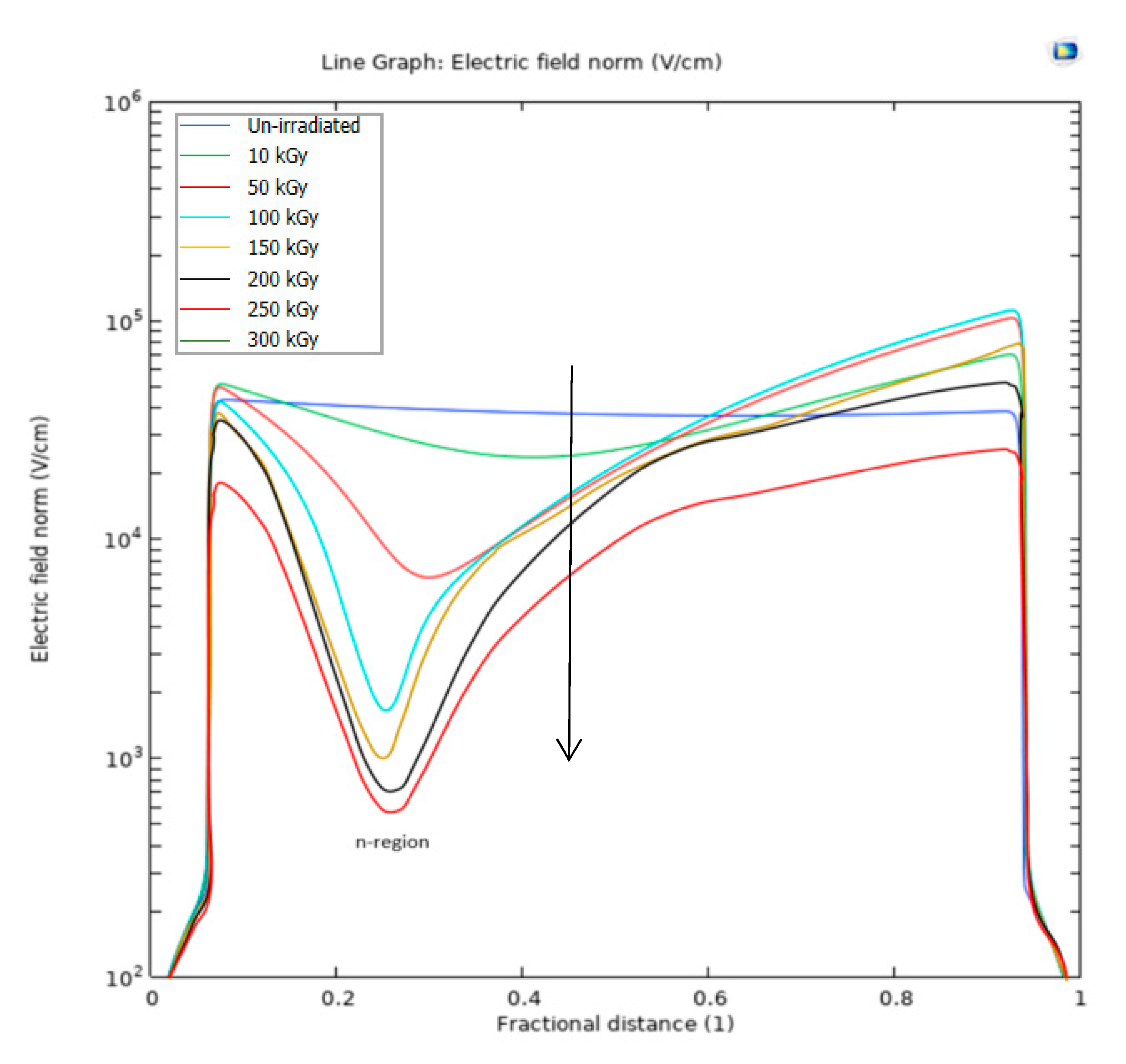
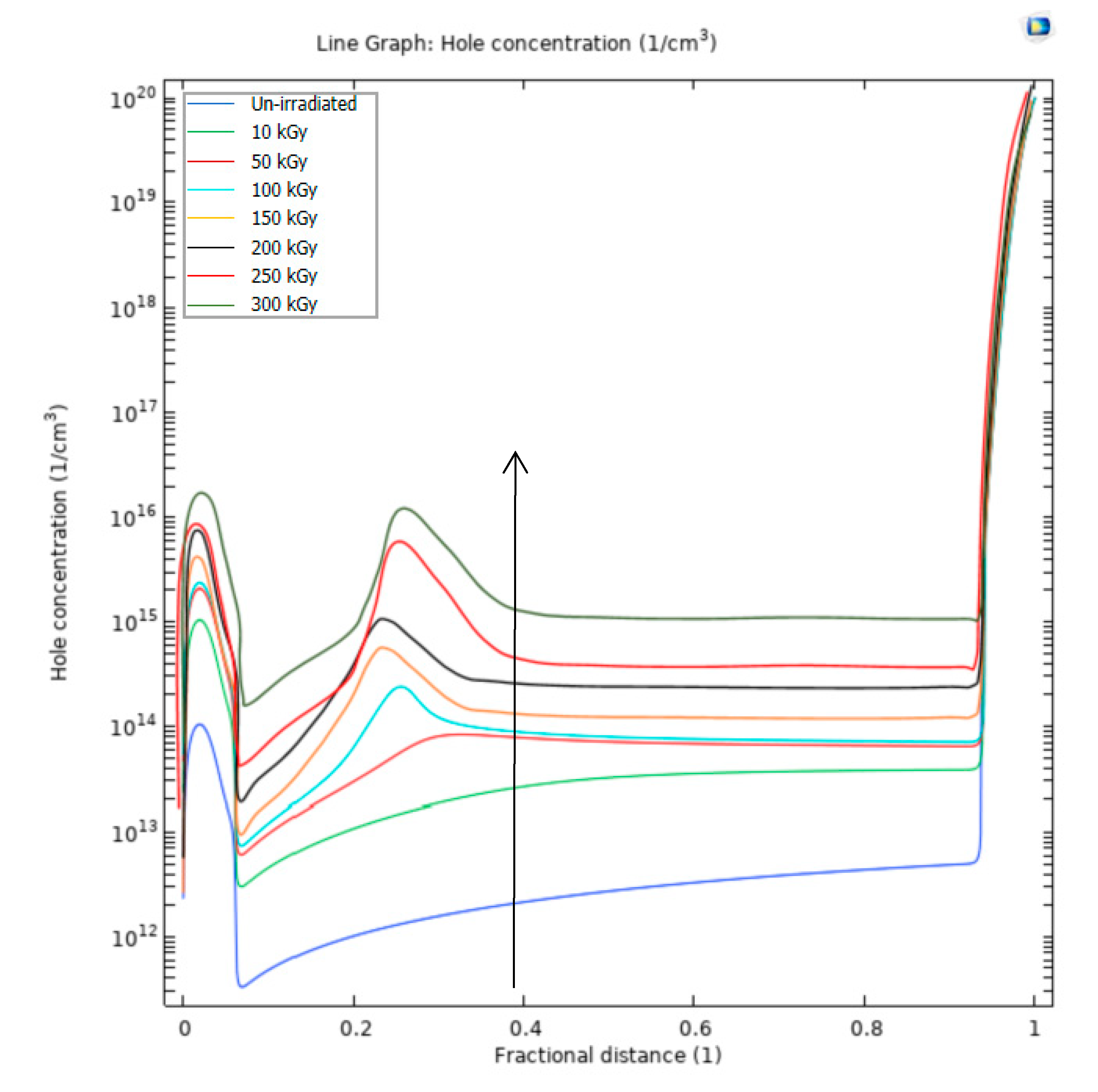
| dV/dlnI | ||||
| Samples | Turn-on-Voltage, | Ideality Factor, | Series Resistance, | Barrier Height, |
| V | n | Rs (Ω) | ɸ(eV) | |
| Un-Irradiated(kGy) | 1.5 | 2.80 | 1680.0 | 0.63 |
| 10 | 1.6 | 30.27 | 1859.0 | 0.56 |
| 50 | 1.8 | 47.94 | 4796.0 | 0.56 |
| 100 | 3.2 | 58.22 | 8596.0 | 0.61 |
| 150 | 4.5 | 68.72 | 36578 | 0.58 |
| 200 | 4.7 | 88.16 | 52348 | 0.45 |
| 250 | 5.2 | 97.162 | 67748 | 0.41 |
| 300 | 7.3 | 102.162 | 102112 | 0.39 |
Disclaimer/Publisher’s Note: The statements, opinions and data contained in all publications are solely those of the individual author(s) and contributor(s) and not of MDPI and/or the editor(s). MDPI and/or the editor(s) disclaim responsibility for any injury to people or property resulting from any ideas, methods, instructions or products referred to in the content. |
© 2023 by the authors. Licensee MDPI, Basel, Switzerland. This article is an open access article distributed under the terms and conditions of the Creative Commons Attribution (CC BY) license (http://creativecommons.org/licenses/by/4.0/).





